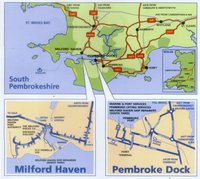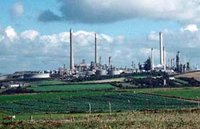Milford Haven, Wales
Milford Haven, Wales (51° 42' 41.57" N 5° 1' 44.92" W), site of one of the largest oil spills in history, where on February 15, 1996 the supertanker Sea Empress ran aground. The crude oil spill of approximately 70,000 tons was the third-largest oil spill in British history. Milford Haven is located in the Pembrokeshire Coast National Park, in Pembrokeshire County, and is the site of a Texaco oil refinery.
Contents
The National Park
Pembrokeshire Coast National Park was designated in 1952. It is the only National Park in Britain that is made up primarily of coastline. The Park is located along the southwest coast of Wales and covers approximately 240 square miles. It is overseen and managed by The National Park Authority. Tourism is very important to the economy of the Pembrokeshire coast, and the area accommodates thousands of visitors each year
The Pembrokeshire Coast has significant ecological and geological importance. It is home to some of the oldest rocks in the region, which date back approximately 600 million years to the Pre-Cambrian period. The geological importance of the area is the main reason for the site’s National Park designation. There are 50 Geological Conservation Review sites in the park and the variety of rock types and landforms are still studied by geologists today. There are also several islands in the Park. Ramsey Island is home to the second-largest grey seal colony in Britain.
Pembrokeshire Coast National Park also has several historic attractions. These include: an Iron Age Fort, circa 600 B.C., an archaeological excavation site; the City of St. David’s which has been a pilgrimage site for thousands of years; and the Carew Castle dating back approximately 2,000 years.
The History of Oil Refining in Milford Haven
Milford Haven became a busy oil port in the late 1950’s after the decline of the area’s fishing industry in the late 1940’s. The naturally deep water channel of the haven could accommodate the large [[supertanker]s] that were developed after the Suez crisis in the 1950’s. Milford Haven had become the largest oil port in Britain and the second-largest in Europe by the 1970’s.
The Texaco oil refinery opened in 1964. It lies on 550 acres of land on the southern shore of Milford Haven, directly adjoining the Pembrokeshire Coast National Park. Every week as many as two to four oil tankers dock at the refinery. These tankers can deliver more than 2 million barrels of crude oil per week from around the world. The refinery employs several hundred people and can produce, on average, up to 210,000 barrels of crude oil per day. The refinery also produces 7,350,000 million gallons of products daily, 50% of which is gasoline.
The refinery is regulated by the Welsh Environmental Agency. Regulations limit air and water emissions and the refinery is inspected frequently by a Site Inspector from the Agency to determine compliance. All water used for the oil refining process is treated before being discharged into the Haven.
The Sea Empress Oil Spill
The supertanker Sea Empress was carrying North Sea (North Sea, Europe) light crude oil from Grangemouth, Scotland, to the Texaco Refinery in Milford Haven. It ran aground in Mill Bay on February 15, 1996, rupturing its oil tanks. The Sea Empress remained at the mouth of Milford Haven until February 21st when she was towed into the haven, still leaking considerable amounts of oil. Over a one week period, 72,000 tons of oil and 370 tons of heavy fuel oil leaked into the waters off the Pembrokeshire County Coast.
The oil spill contaminated about 200 km of the Pembrokeshire coast, including several marine and nature reserves and conservation and fishery sites. Thirty-five sites of scientific interest and 20 National Trust properties were affected. A large spring tide at the time of the accident worsened the impact of the pollution onshore by pushing the oil-polluted water higher up onto the rocky shore.
Huge oil slicks remained at sea and the shores were polluted with oil through February and March of 1996. Natural dispersion of the oil pollution and a massive cleanup effort cleared the majority of the bulk oil at sea and onshore by April. The sands of the beach were cleaned thoroughly and were ready for tourism and recreation by the popular Easter holiday, but residual oil pollution plagued the beaches through the summer of 1996. An active storm season in the fall of 1996 temporarily created new oil sheens and tar balls along the coast. However, the stormy weather proved beneficial in the end as it aided the natural cleansing of the shoreline. By spring of the next year, there was little evidence of the oil pollution on the shores of the Pembrokeshire Coast.
Costs for cleanup and compensation payments totaled approximately 66,500,000 U.S. dollars. The local authority spent over 8.75 million U.S. Dollars for recovery of the area.
Aftermath
Because of the area’s ecological importance, a huge monitoring effort, carried out by scientists from several research organizations, was made to study the effects of the oil spill on the area. The area’s bird populations were most affected by the spill with thousands of avian casualties reported. Populations of seaweeds, invertebrates, shellfish, and rock pool fish were also severely damaged. However, the grey seals and several shore species were spared any serious harm. Fishing was immediately banned and the ban was only lifted, in stages, following testing of shellfish and finfish by the Welsh Government. While the area seemed to recover quickly, the potential for future damage remains because residues of oil remain deep in the shores of muddy beaches, such as that of Milford Haven.
As a result of the Sea Empress oil spill, new preventative measures were enacted by the UK government. Large vessels are now escorted into Milford Haven and two pilots must be onboard vessels carrying over 120,000 deadweight tonnage. Only one pilot was aboard the Sea Empress. Computer models are now used to analyze the unpredictable tides in Pembrokeshire to be better prepared. The government has investigated how their response could be improved in the event of another oil spill.
Cited as an enduring problem is the structure of governance over activities along the Pembrokeshire Coast. While the Welsh Assembly Government has authority to regulate and protect the country from the shoreline out to 12 nautical miles at sea, certain activities, including the development and shipment of oil and gas, are under the authority of the Department of Trade and Industry. Some are concerned that this governance structure has led to an uncoordinated effort in regulating the Welsh seas and coastline and could lead to another environmental disaster.


